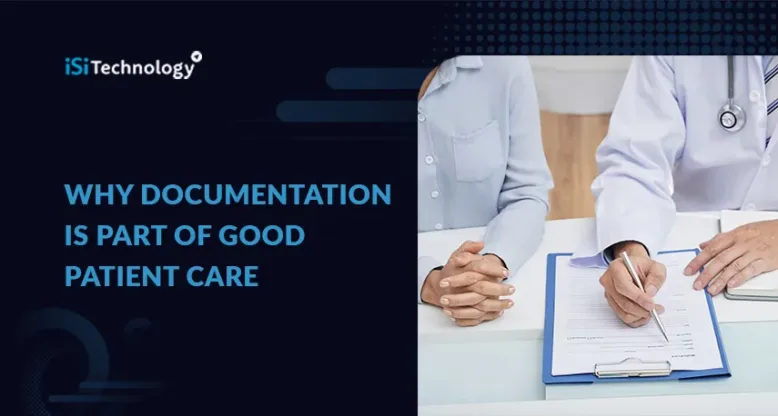Why Documentation is Part of Good Patient Care

Documentation is a critical element of medical care. After all, health is a continuum and must be integrated across practitioners and facilities over the years. Achieving comprehensive and holistic care is why documentation is important in healthcare.
The Vital Role of Documentation in Delivering Quality Patient Care
Patient care doesn’t just fall in the hands of doctors. Every staff member that a patient interacts with, from intake to discharge, will affect their prognosis and future health.
For example, a patient goes to a clinic for a checkup. They go to the front desk for registration or triage. They fill out forms, and then the staff will direct them to the right doctor.
The patient then goes in for a consultation and is diagnosed with a certain condition. The doctor gives their medical recommendation, prescribes some medication, and then guides the patient to the pharmacy. Meanwhile, the patient’s record is forwarded to the billing department for payment or insurance claims.
There are multiple complex steps involved in this seemingly simple process. Without proper documentation, it would be difficult for everybody involved to remember the specifics of that medical visit, even the patient.
3 Main Reasons Documentation is Important in Healthcare
It’s clear that there are many reasons why proper documentation is critical for patient care. These benefits can be categorized into the following: protection of the healthcare program, the patient, and the medical facility.
1. Protection of the Program
The example above only demonstrates the basic healthcare process—every facility has its own set of protocols based on current healthcare trends. But across the board, for all protocols, accurate documentation is critical. Reports are needed to determine if the program is working for the facility and if it the system needs to be improved or replaced altogether.
2. Protection of the Patient
The patient’s well-being is the most important element of healthcare and should be the focal point of proper record-keeping. All healthcare practitioners want to ensure the patient gets the right care and treatment—documentation will help provide that.
Patient care should be comprehensive and integrated, so it involves various medical staff through each step of diagnosis and treatment. Their medical history and record of every visit will determine the best possible care and treatment.
For example, a patient goes in for a checkup because there was blood in their phlegm. The attending physician will do a physical checkup and ask the patient questions about their medical history and their current health complaint. The doctor will document their preliminary findings and order tests:
- Blood test
- Bronchoscopy
- Chest X-ray
- CT scan
All of these tests will be handled by other medical personnel across several departments, and they all must properly document their findings. The attending physician will read through all the reports before making a diagnosis and recommending treatment.
With proper documentation, the patient will get the appropriate medical procedures and treatments for their disease.
3. Protection of the Medical Facility
The importance of documentation in healthcare cannot be overstated for the benefit of the facility itself. For one, the livelihoods of all personnel, from the support staff to the doctors, will be kept safe. Proper documentation will ensure timely payments, correct insurance claims, and good patient experiences, leading to a positive reputation.
Documentation can also save the facility if it is sued for malpractice or other legal issues. Accurate records and thorough reports are critical evidence for such cases.
Legal and Ethical Considerations: How Documentation Supports Patient Rights and Safety

It is the right of every patient to get proper medical care.
However, a 2016 study that spanned five years found that 1,744 deaths may have been avoided if the medical staff communicated better amongst themselves.
As an example, the study stated that a nurse failed to inform the surgeon that the patient was having abdominal pain after an operation. There was also a drop in red blood cells. These were signs of internal bleeding that could have been treated, but communication failure caused the patient to die of hemorrhage.
Had the facility practiced proper documentation at each step of treatment, death could have been avoided. The nurse should have immediately recorded their observation. Better yet, it should have been noted in a central system that would have informed all concerned healthcare personnel.
This incident also resulted in a malpractice suit.
Communication through proper documentation can also be the legal defense of a medical team against malpractice. If the facility proves it did everything possible to save the patient, the suit cannot continue.
Documentation truly benefits everyone concerned.
Documentation Best Practices: Strategies for Effective and Efficient Record-Keeping

The importance of good documentation process is highlighted in healthcare. So many things could go wrong because of a missing piece of information or an error in the documentation process. It is about recording everything thoroughly and accurately.
Here are some of the best practices for effective record-keeping in healthcare:
1. Document Everything
Let’s go back to the malpractice example of a nurse failing to report abdominal pain experienced by the patient. The nurse, who had years of experience watching over surgical patients, must have thought it was natural to have post-surgery abdominal pain. So, they thought nothing more of it.
But efficient record-keeping dictates that staff must record all observations, including what one may think as mundane. Records must cover the entire medical experience for healthcare practitioners to provide the most comprehensive and holistic care.
2. Set Up a Central Repository for Documentation
Documentation will not mean much if the right people cannot access it. There should be a digital central system to store all patient information and medical diagnosis and treatments over the years.
A customer relationship management (CRM) system is not just for retail. CRM in healthcare can enhance the patient experience. Attending physicians can also pull up patient records within seconds.
3. Train Staff
All staff in the medical facility must be apprised of the software used for documentation. However, limited access to the system must be maintained to prevent overreporting and malicious activities.
Moreover, standard language and terminology must be used to prevent miscommunication.
Documentation in the Digital Age: Exploring Electronic Health Records (EHR) and Benefits
Gone are the days when documents needed to be written on paper, filed in folders, and stored in steel cabinets. Healthcare facilities must embrace technology to provide better patient care. Software also streamlines workflows, as staff can easily access all relevant records within a central system.
EHR is not just a digital filing system. It also integrates evidence-based tools that can help medical practitioners make the best decisions for patient care based on related situations from other facilities around the globe.
Technology and the internet could make the healthcare industry so much better. Further developments involving blockchain technology can also improve patient care.
Conclusion
When equipped with the right information and knowledge, a medical facility can provide excellent care for all patients. All healthcare providers must practice proper documentation of every step of a patient’s health journey.
It is important to utilize efficient software to elevate healthcare. iSi Technology provides much-needed tools to help medical facilities provide better holistic medical services.